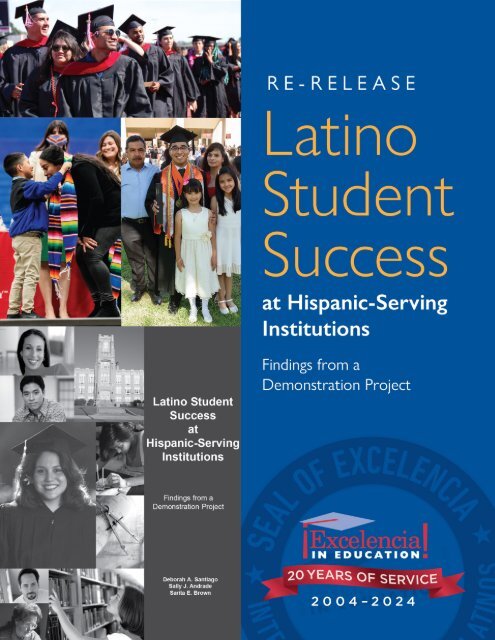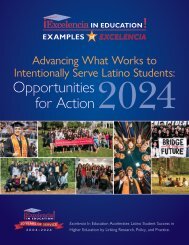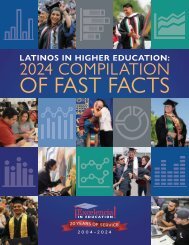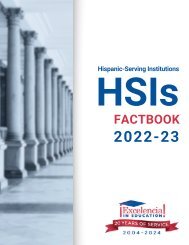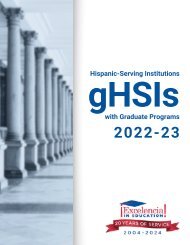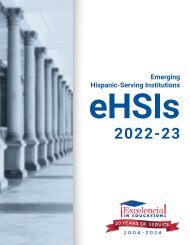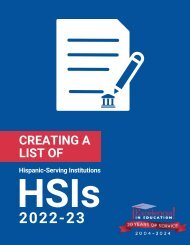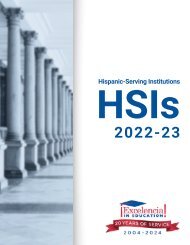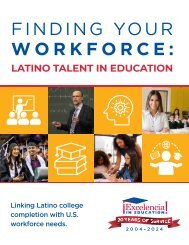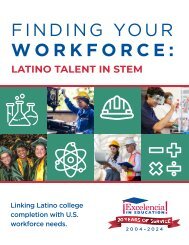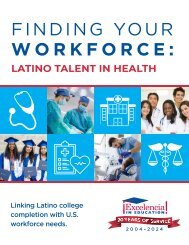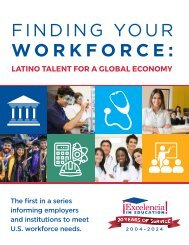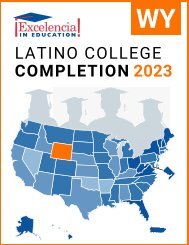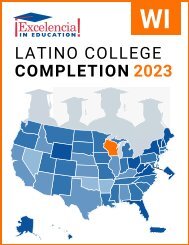Re-Release: Latino Student Success at Hispanic-Serving Institutions
Findings from a demonstration project.
Findings from a demonstration project.
You also want an ePaper? Increase the reach of your titles
YUMPU automatically turns print PDFs into web optimized ePapers that Google loves.
R E - R E L E A S E<br />
<strong>L<strong>at</strong>ino</strong> <strong>Student</strong><br />
<strong>Success</strong><br />
<strong>at</strong><br />
<strong>Hispanic</strong>-<strong>Serving</strong><br />
<strong>Institutions</strong><br />
Findings from a<br />
Demonstr<strong>at</strong>ion Project<br />
Deborah A. Santiago<br />
Sally J. Andrade<br />
Sarita E. Brown<br />
1
RE-RELEASE<br />
<strong>L<strong>at</strong>ino</strong> <strong>Student</strong> <strong>Success</strong> <strong>at</strong> HSIs:<br />
FINDINGS FROM A DEMONSTRATION PROJECT<br />
January 2024 (<strong>Re</strong>-<strong>Re</strong>lease)<br />
AUTHOR:<br />
Deborah A. Santiago, CEO and Co-Founder<br />
Sally J. Andrade, former Director, Center for Institutional Evalu<strong>at</strong>ion, <strong>Re</strong>search and Planning, The<br />
University of Texas <strong>at</strong> El Paso<br />
Sarita E. Brown, President and Co-Founder<br />
ACKNOWLEDGMENTS:<br />
This public<strong>at</strong>ion is a re-release of Excelencia in Educ<strong>at</strong>ion’s first public<strong>at</strong>ion released in 2004. A<br />
foreword has been added as a reflection of the 20 years since the first public<strong>at</strong>ion was released,<br />
but the content of the issue brief has not been upd<strong>at</strong>ed or changed. The authors are solely<br />
responsible for the content, opinions, and any errors in this public<strong>at</strong>ion.<br />
SUGGESTED CITATION:<br />
Santiago, D., Andrade, S. J, & Brown, S. (2024). <strong>Re</strong>-<strong>Re</strong>lease - <strong>L<strong>at</strong>ino</strong> <strong>Student</strong> <strong>Success</strong> <strong>at</strong> HSIs:<br />
Findings from a Demonstr<strong>at</strong>ion Project. Washington, D.C.: Excelencia in Educ<strong>at</strong>ion.<br />
For more inform<strong>at</strong>ion about this public<strong>at</strong>ion, contact: contact@edexcelencia.org<br />
Excelencia in Educ<strong>at</strong>ion acceler<strong>at</strong>es <strong>L<strong>at</strong>ino</strong> student success in higher educ<strong>at</strong>ion by promoting<br />
<strong>L<strong>at</strong>ino</strong> student achievement, conducting analysis to inform educ<strong>at</strong>ional policy, and advancing<br />
institutional practices while collabor<strong>at</strong>ing with those committed and ready to meet our mission.<br />
Launched in 2004 in the n<strong>at</strong>ion’s capital, Excelencia is building a network of results-oriented<br />
educ<strong>at</strong>ors and policymakers to address the U.S. economy’s need for a highly educ<strong>at</strong>ed workforce<br />
and engaged civic leadership. For more inform<strong>at</strong>ion, visit: www.EdExcelencia.org.
FOREWORD<br />
January 2024 marks the 20th anniversary of the founding of Excelencia in Educ<strong>at</strong>ion in<br />
Washington D.C. as a n<strong>at</strong>ional nonprofit organiz<strong>at</strong>ion with the mission of acceler<strong>at</strong>ing <strong>L<strong>at</strong>ino</strong> student<br />
success in higher educ<strong>at</strong>ion. We signaled our intentions right away with the release of our first<br />
public<strong>at</strong>ion, “<strong>L<strong>at</strong>ino</strong> <strong>Student</strong>s <strong>Success</strong> <strong>at</strong> <strong>Hispanic</strong>-<strong>Serving</strong> <strong>Institutions</strong>: Findings from a Demonstr<strong>at</strong>ion<br />
Project.” It is reaffirming to see much of the research on HSIs today reinforces the framing and findings<br />
from this seminal project by continuing to address the fundamental question of how an institution<br />
“serves” students. Excelencia’s work, 20 years l<strong>at</strong>er, also continues to expand on the insights from this<br />
first public<strong>at</strong>ion.<br />
Excelencia’s journey to build a d<strong>at</strong>a driven, results-oriented organiz<strong>at</strong>ion using an unapologetic<br />
<strong>L<strong>at</strong>ino</strong> lens th<strong>at</strong> informs and compels action is grounded in the professional experiences and capacities<br />
of two L<strong>at</strong>inas. We cre<strong>at</strong>ed an agenda to assert the benefits of intentionally serving <strong>L<strong>at</strong>ino</strong> students for<br />
both higher educ<strong>at</strong>ion and for our country’s future. We also committed to highlighting opportunities for<br />
higher educ<strong>at</strong>ion to engage, enroll, gradu<strong>at</strong>e, and advance <strong>L<strong>at</strong>ino</strong> students prepared to enter the<br />
workforce and leadership roles in our society.<br />
We purposely chose to examine <strong>Hispanic</strong>-<strong>Serving</strong> <strong>Institutions</strong> (HSIs) and their impact on <strong>L<strong>at</strong>ino</strong><br />
student success for our first public<strong>at</strong>ion. And we did so in partnership with six HSIs willing to self-assess<br />
and demonstr<strong>at</strong>e their intentionality and impact. This was our first group of trendsetting HSIs. Among<br />
the framing components shared in the public<strong>at</strong>ion th<strong>at</strong> continue to reson<strong>at</strong>e 20 years l<strong>at</strong>er on HSIs<br />
include the following:<br />
1. <strong>Hispanic</strong> “serving” institutions must actively promote <strong>L<strong>at</strong>ino</strong> students’ success, not<br />
just enroll <strong>Hispanic</strong> students.<br />
2. <strong>L<strong>at</strong>ino</strong> student success includes more than degree completion. <strong>Student</strong> engagement in<br />
campus activities, continuous enrollment, employment beyond gradu<strong>at</strong>ion, and enrollment in<br />
gradu<strong>at</strong>e educ<strong>at</strong>ion are also part of student success.<br />
3. Multiple measures of institutional effectiveness and incentives for educ<strong>at</strong>ing <strong>L<strong>at</strong>ino</strong><br />
students are critical as HSIs lead and develop innov<strong>at</strong>ive practices th<strong>at</strong> promote student success<br />
and can serve other students as well.<br />
The Seal of Excelencia—today’s n<strong>at</strong>ional certific<strong>at</strong>ion for colleges and universities th<strong>at</strong> can show with<br />
d<strong>at</strong>a, practice, and leadership how they are intentionally serving <strong>L<strong>at</strong>ino</strong> students, was also informed by<br />
the institutional practices facilit<strong>at</strong>ing <strong>L<strong>at</strong>ino</strong> student success summarized in this public<strong>at</strong>ion. The practices<br />
noted 20 years ago included the following:<br />
• Use disaggreg<strong>at</strong>ed d<strong>at</strong>a of students and institutional services to identify areas of need,<br />
target limited resources, and emphasize educ<strong>at</strong>ional success for <strong>L<strong>at</strong>ino</strong> students.<br />
• Partner with “feeder” schools or community-based organiz<strong>at</strong>ions to increase <strong>L<strong>at</strong>ino</strong><br />
student access and their prepar<strong>at</strong>ion for success.<br />
• Have proactive institutional leaders who facilit<strong>at</strong>e <strong>L<strong>at</strong>ino</strong> student success.<br />
• Adopt a holistic approach to serving <strong>L<strong>at</strong>ino</strong> students—incorpor<strong>at</strong>ing leadership,<br />
institutional research, academic programs, support services, and student life programs.<br />
• Practices th<strong>at</strong> facilit<strong>at</strong>e <strong>L<strong>at</strong>ino</strong> student success improves the learning and<br />
development of all students <strong>at</strong> an institution.
Two decades l<strong>at</strong>er, we recognize the through-line from this study to Excelencia’s powerful<br />
portfolio, tactical plan, and proven impact. We have not wavered in our str<strong>at</strong>egy to inform and compel<br />
action in higher educ<strong>at</strong>ion or our commitment to an asset-based approach to acceler<strong>at</strong>e <strong>L<strong>at</strong>ino</strong> student<br />
success by working with a coalition of institutions willing to become places where <strong>L<strong>at</strong>ino</strong>s, and all, thrive.<br />
Consistent with the work and finding in this brief, our efforts today continue to include:<br />
• Promoting evidence-based practices th<strong>at</strong> show impact for <strong>L<strong>at</strong>ino</strong> students among all served<br />
• Advancing multiple measures of student success including, but also beyond, completion<br />
• <strong>Serving</strong> as an intermediary for a network of institutional leaders committed to transforming their<br />
colleges and universities into places where <strong>L<strong>at</strong>ino</strong>, and all, students thrive<br />
• Informing policy with good practices showing positive impact and convening professionals setting the<br />
n<strong>at</strong>ional policy agenda to acceler<strong>at</strong>e <strong>L<strong>at</strong>ino</strong> student success<br />
• Raising expect<strong>at</strong>ions and opportunities for intentionally serving <strong>L<strong>at</strong>ino</strong>, and all, students through the<br />
Seal of Excelencia n<strong>at</strong>ional certific<strong>at</strong>ion<br />
We are proud to learn from and facilit<strong>at</strong>e work with leaders and practitioners th<strong>at</strong> have<br />
c<strong>at</strong>alyzed and supported colleges and universities to make common cause and hold themselves<br />
accountable to go beyond enrolling <strong>L<strong>at</strong>ino</strong> to intentionally serve them.<br />
As a community, we have made significant strides over the last 20 years to change higher<br />
educ<strong>at</strong>ion to ensure our students are served. For example, of the six institutions in this seminal project,<br />
all have had leadership change, five have continued to partner in our Presidents for <strong>L<strong>at</strong>ino</strong> <strong>Student</strong><br />
<strong>Success</strong> network, and three have earned the Seal of Excelencia. We invite you to read this seminal brief,<br />
learn more about Excelencia’s continuing leadership efforts, and join us as we continue acceler<strong>at</strong>ing<br />
<strong>L<strong>at</strong>ino</strong> student success in higher educ<strong>at</strong>ion.<br />
Sincerely,<br />
Deborah A. Santiago<br />
Co-Founders<br />
Sarita E. Brown
<strong>L<strong>at</strong>ino</strong> <strong>Student</strong> <strong>Success</strong><br />
<strong>at</strong><br />
<strong>Hispanic</strong>-<strong>Serving</strong> <strong>Institutions</strong><br />
Deborah A. Santiago<br />
Sally J. Andrade<br />
Sarita E. Brown<br />
January 2024<br />
Findings From a Demonstr<strong>at</strong>ion Project<br />
Supported by the<br />
Fund for the Improvement of Postsecondary Educ<strong>at</strong>ion (FIPSE)<br />
U.S. Department of Educ<strong>at</strong>ion<br />
Grant No. P116U030001
PARTICIPATING INSTITUTIONS<br />
California St<strong>at</strong>e University-Dominguez Hills<br />
James E. Lyons, President<br />
Steve Frieze, Director of Institutional <strong>Re</strong>search and Testing Services<br />
Randy Zarn, Associ<strong>at</strong>e Vice President of <strong>Student</strong> Life<br />
California St<strong>at</strong>e University-Los Angeles<br />
James M. Rosser, President<br />
Alfredo Gonzalez, Dean of Undergradu<strong>at</strong>e Studies<br />
Anthony Ross, Vice President for <strong>Student</strong> Affairs<br />
City University of New York-Lehman College<br />
Ricardo R. Fernández, President<br />
Anne Prisco, Associ<strong>at</strong>e Provost and Assistant Vice President for Enrollment Management<br />
Michael Sullivan, Director of Campus Life<br />
City University of New York-New York City College of Technology<br />
Fred W. Beaufait, President<br />
Sherry Ondrus, Director of Assessment and Institutional <strong>Re</strong>search<br />
Daniel Fictum, Director of <strong>Student</strong> Life and Development<br />
The University of Texas <strong>at</strong> El Paso<br />
Diana N<strong>at</strong>alicio, President<br />
Sally J. Andrade, Director, Center for Institutional Evalu<strong>at</strong>ion, <strong>Re</strong>search and Planning<br />
Lisa Campos-Emmert, Associ<strong>at</strong>e Athletics Director/Senior Woman Administr<strong>at</strong>or<br />
The University of Texas <strong>at</strong> San Antonio<br />
Ricardo Romo, President<br />
P<strong>at</strong>ricia Glenn, Executive Director, Tomás Rivera Center for <strong>Student</strong> <strong>Success</strong><br />
Leticia Duncan, Director, Learning Assistance Program<br />
PROJECT TEAM<br />
Co-Principal Investig<strong>at</strong>ors<br />
Sally J. Andrade, Director, Center for Institutional Evalu<strong>at</strong>ion, <strong>Re</strong>search and Planning<br />
The University of Texas <strong>at</strong> El Paso<br />
Sarita E. Brown, President, Excelencia in Educ<strong>at</strong>ion,<br />
and Senior Fellow, Pew <strong>Hispanic</strong> Center, Washington, DC<br />
Analysis Coordin<strong>at</strong>or<br />
Elea Uraga, <strong>Re</strong>search Associ<strong>at</strong>e, Center for Institutional Evalu<strong>at</strong>ion, <strong>Re</strong>search and Planning<br />
The University of Texas <strong>at</strong> El Paso<br />
<strong>Student</strong> Chapters Coordin<strong>at</strong>or<br />
Tara Ballesteros, Program Associ<strong>at</strong>e<br />
<strong>Hispanic</strong> Scholarship Fund Institute, Washington, DC<br />
Consultant, Policy Brief<br />
Deborah A. Santiago, Principal, Excelencia in Educ<strong>at</strong>ion<br />
and, Irvine Fellow, University of Southern California
Contents<br />
Executive Summary……………………………………… 1<br />
Project Overview………………………………………… 2<br />
Wh<strong>at</strong> it Means to be <strong>Hispanic</strong> <strong>Serving</strong>…………………. 3<br />
<strong>Serving</strong> <strong>L<strong>at</strong>ino</strong>s While <strong>Serving</strong> All <strong>Student</strong>s……….. 4<br />
Institutional Activities……………..………………. 5<br />
Institutional Leadership…………....………… 5<br />
Academic Programs and Services…………… 6<br />
<strong>Student</strong> Life Programs and Services………… 7<br />
Community Outreach……………………….. 8<br />
Defining <strong>L<strong>at</strong>ino</strong> <strong>Student</strong> <strong>Success</strong>……………………..…. 8<br />
Useful and Appropri<strong>at</strong>e Measures of Accountability …… 9<br />
Policy Issues ….………………………………………… 11<br />
Conclusion ………………………………………………12<br />
<strong>Re</strong>ferences ……………………………………………… 14
This public<strong>at</strong>ion is available on the <strong>L<strong>at</strong>ino</strong> <strong>Student</strong> <strong>Success</strong> project link <strong>at</strong><br />
.<br />
In addition to this summary brief of initial findings the project produced:<br />
• An overview of the institutional presidents’ perspectives, available <strong>at</strong><br />
<br />
• Inform<strong>at</strong>ion about the six particip<strong>at</strong>ing campuses in d<strong>at</strong>a tables available<br />
<strong>at</strong> <br />
• Inform<strong>at</strong>ion collection tools including the Institutional Profile-Focus on<br />
<strong>L<strong>at</strong>ino</strong> <strong>Student</strong>s and the Campus Comparison Chart (see the templ<strong>at</strong>es<br />
and suggestions for their use <strong>at</strong> ).
EXECUTIVE SUMMARY<br />
Almost half of <strong>L<strong>at</strong>ino</strong> students in higher educ<strong>at</strong>ion are enrolled <strong>at</strong> <strong>Hispanic</strong>-<strong>Serving</strong> <strong>Institutions</strong><br />
(HSIs). One approach to study <strong>L<strong>at</strong>ino</strong> student success is to focus on these institutions. The purpose<br />
of the <strong>L<strong>at</strong>ino</strong> <strong>Student</strong> <strong>Success</strong> <strong>at</strong> <strong>Hispanic</strong>-<strong>Serving</strong> <strong>Institutions</strong> (HSIs) demonstr<strong>at</strong>ion project was to<br />
develop gre<strong>at</strong>er understanding about institutional leadership and practices th<strong>at</strong> promote <strong>L<strong>at</strong>ino</strong><br />
student success <strong>at</strong> six particip<strong>at</strong>ingHSIs.<br />
• California St<strong>at</strong>e University—Dominguez Hills<br />
• City University of New York—Lehman College<br />
• The University of Texas <strong>at</strong> El Paso<br />
• California St<strong>at</strong>e University—Los Angeles<br />
• City University of New York—New York City College of Technology<br />
• The University of Texas <strong>at</strong> SanAntonio<br />
The six HSIs were current recipients of the federal Title V: Developing HSIs program, with<br />
institutional practices and strong institutional leadership th<strong>at</strong> could inform a broader public<br />
discussion about <strong>L<strong>at</strong>ino</strong> student success. This demonstr<strong>at</strong>ion project was partially supported by<br />
the Fund for the Improvement of Postsecondary Educ<strong>at</strong>ion (FIPSE), U.S. Department of<br />
Educ<strong>at</strong>ion.<br />
This brief summarizes the discussions by the particip<strong>at</strong>ing institutions over a 12-month period<br />
and their views about institutional practices th<strong>at</strong> facilit<strong>at</strong>e <strong>L<strong>at</strong>ino</strong> student success. The brief also<br />
examines characteristics of institutions th<strong>at</strong> serve <strong>L<strong>at</strong>ino</strong>s, as well as ways to measure <strong>L<strong>at</strong>ino</strong> student<br />
success and institutional effectiveness.<br />
The six HSIs had consensus on three key policy issues:<br />
1. Enrolling <strong>L<strong>at</strong>ino</strong> students is not sufficient to characterize HSIs; <strong>Hispanic</strong> “serving” institutions<br />
must actively promote <strong>L<strong>at</strong>ino</strong> students’ success. Analysis of institutional elements beyond <strong>Hispanic</strong><br />
enrollment should be conducted th<strong>at</strong> better illustr<strong>at</strong>e effective service to <strong>L<strong>at</strong>ino</strong> students.<br />
2. While the six HSIs concurred th<strong>at</strong> one important element of <strong>L<strong>at</strong>ino</strong> student success is the<br />
completion of a baccalaure<strong>at</strong>e degree, other elements of success, such as student engagement in<br />
campus activities, continuous enrollment, employment beyond gradu<strong>at</strong>ion, and enrollment in<br />
gradu<strong>at</strong>e educ<strong>at</strong>ion should also be considered in defining student success.<br />
3. Multiple measures of institutional effectiveness and incentives for educ<strong>at</strong>ing <strong>L<strong>at</strong>ino</strong> students,<br />
r<strong>at</strong>her than penalties based on wh<strong>at</strong> some perceive as low persistence or gradu<strong>at</strong>ion r<strong>at</strong>es, are<br />
critical as HSIs look to lead and develop innov<strong>at</strong>ive practices th<strong>at</strong> promote student success.<br />
The particip<strong>at</strong>ing HSIs identified the following practices as facilit<strong>at</strong>ing <strong>L<strong>at</strong>ino</strong> student success:<br />
• Use disaggreg<strong>at</strong>ed d<strong>at</strong>a of students and institutional services to identify areas of need, target<br />
limited resources, and emphasize educ<strong>at</strong>ional success for <strong>L<strong>at</strong>ino</strong> students.<br />
• Partner with “feeder” high schools, community colleges, and community-based organiz<strong>at</strong>ions<br />
to increase <strong>L<strong>at</strong>ino</strong> student access and their prepar<strong>at</strong>ion for transition to a baccalaure<strong>at</strong>egranting<br />
institution.<br />
• Have proactive institutional leaders who actively facilit<strong>at</strong>e <strong>L<strong>at</strong>ino</strong> student success.<br />
• Adopt a holistic approach to serving <strong>L<strong>at</strong>ino</strong> students—incorpor<strong>at</strong>ing leadership, institutional<br />
research, academic programs, support services, and student life programs.<br />
• Implement institutional practices th<strong>at</strong> facilit<strong>at</strong>e <strong>L<strong>at</strong>ino</strong> student success to ultim<strong>at</strong>ely improve<br />
the learning and development of all students <strong>at</strong> an institution.<br />
1
PROJECT OVERVIEW<br />
<strong>L<strong>at</strong>ino</strong>s are enrolling in colleges and universities <strong>at</strong> historic r<strong>at</strong>es. They are one of the fastest<br />
growing groups enrolling in higher educ<strong>at</strong>ion and currently represent 10 percent of students. About<br />
85 percent of <strong>L<strong>at</strong>ino</strong>s in higher educ<strong>at</strong>ion are enrolled in public institutions and almost half (45<br />
percent) are enrolled in <strong>Hispanic</strong>-<strong>Serving</strong> <strong>Institutions</strong> (HSIs). Further, a majority of <strong>L<strong>at</strong>ino</strong> students<br />
in higher educ<strong>at</strong>ion (over 55 percent) are enrolled in three st<strong>at</strong>es: California, New York and Texas<br />
(NCES, 2003). While there is document<strong>at</strong>ion of <strong>L<strong>at</strong>ino</strong> particip<strong>at</strong>ion in higher educ<strong>at</strong>ion, there is<br />
little research focused on <strong>L<strong>at</strong>ino</strong> student success.<br />
Wh<strong>at</strong> is success for a <strong>L<strong>at</strong>ino</strong> college student (and <strong>L<strong>at</strong>ino</strong>s as a group), how is success facilit<strong>at</strong>ed,<br />
and how is success measured? To explore these questions, represent<strong>at</strong>ives from six institutions<br />
serving a large percentage of <strong>L<strong>at</strong>ino</strong> students were invited to particip<strong>at</strong>e in a 12-month research<br />
project th<strong>at</strong> compared institutional practices and outcomes for <strong>L<strong>at</strong>ino</strong> students. This demonstr<strong>at</strong>ion<br />
project entitled, “<strong>L<strong>at</strong>ino</strong> <strong>Student</strong> <strong>Success</strong> <strong>at</strong> <strong>Hispanic</strong> <strong>Serving</strong> <strong>Institutions</strong>” was partially supported<br />
by the Fund for the Improvement of Postsecondary Educ<strong>at</strong>ion (FIPSE), U.S. Department of Educ<strong>at</strong>ion.<br />
Two public baccalaure<strong>at</strong>e-granting institutions from each of the three st<strong>at</strong>es with the most<br />
<strong>L<strong>at</strong>ino</strong> students in their higher educ<strong>at</strong>ion systems (California, New York, and Texas) were invited to<br />
particip<strong>at</strong>e. The institutions were identified as current recipients of the federal Title V Developing<br />
HSIs program, with institutional practices and strong institutional leadership th<strong>at</strong> could inform a<br />
broader public about <strong>L<strong>at</strong>ino</strong> student success. Joining these academic institutions to facilit<strong>at</strong>e student<br />
chapters was the <strong>Hispanic</strong> Scholarship Fund Institute.<br />
Only 20 percent (47) of public HSIs offer bachelor’s<br />
degrees (IPEDS, 2001). Of these, the six HSIs in the project<br />
represent 13 percent of public baccalaure<strong>at</strong>e-granting HSIs,<br />
and together enroll over 36,500 <strong>L<strong>at</strong>ino</strong>s in higher educ<strong>at</strong>ion<br />
(about 10 percent of <strong>Hispanic</strong> students <strong>at</strong> HSIs). While these<br />
six institutions are HSIs, they are all diverse. Some of the<br />
institutions have a long history of serving <strong>L<strong>at</strong>ino</strong> students while<br />
others are only now facing a large <strong>L<strong>at</strong>ino</strong> student body.<br />
Combined, their <strong>L<strong>at</strong>ino</strong> represent<strong>at</strong>ion on campus ranges from<br />
Three of the top five institutions awarding<br />
bachelor’s degrees to <strong>L<strong>at</strong>ino</strong> students on the<br />
U.S. mainland in 2001 particip<strong>at</strong>ed in this<br />
project:<br />
1. Florida Intern<strong>at</strong>ional University<br />
2. The University of Texas-Pan American<br />
3. California St<strong>at</strong>e University-Los Angeles<br />
4. The University of Texas <strong>at</strong> San Antonio<br />
5. The University of Texas <strong>at</strong> El Paso<br />
(IPEDS, 2001-02)<br />
27 to 73 percent of their undergradu<strong>at</strong>e students. Over 94 percent of their students commute, and<br />
between 70 to 90 percent receive some form of financial aid. In addition, 30 to 45 percent of their<br />
students enroll part-time, and 50 to 75 percent of their students are female.<br />
The president of each particip<strong>at</strong>ing institution selected staff from the offices of institutional<br />
research, academic services, and student life to form campus teams th<strong>at</strong> examined institutional d<strong>at</strong>a,<br />
resources, and practices pertinent to <strong>L<strong>at</strong>ino</strong> student success. These campus teams then particip<strong>at</strong>ed<br />
in an extended multi-campus dialogue with other project members on <strong>L<strong>at</strong>ino</strong> student success and<br />
compared institutional activities th<strong>at</strong> facilit<strong>at</strong>e this success.<br />
The participants addressed three areas:<br />
1. Understanding wh<strong>at</strong> it means for a college to be “<strong>Hispanic</strong> serving” and how an institution<br />
facilit<strong>at</strong>es <strong>L<strong>at</strong>ino</strong> studentsuccess.<br />
2. Defining <strong>L<strong>at</strong>ino</strong> student success.<br />
3. Exploring useful and appropri<strong>at</strong>e indic<strong>at</strong>ors for institutions to hold themselves accountable<br />
for educ<strong>at</strong>ing <strong>L<strong>at</strong>ino</strong>s.<br />
2
WHAT IT MEANS TO BE HISPANIC SERVING<br />
The identific<strong>at</strong>ion of a set of institutions as HSIs origin<strong>at</strong>ed in the 1990s and placed the<br />
emphasis on large <strong>Hispanic</strong> student enrollment. HSIs are defined in federal legisl<strong>at</strong>ion as public or<br />
not-for-profit institutions of higher educ<strong>at</strong>ion th<strong>at</strong> enroll 25 percent or more undergradu<strong>at</strong>e <strong>Hispanic</strong><br />
full-time equivalent students, have low educ<strong>at</strong>ional and general expenditures, and a high enrollment<br />
of needy students (Higher Educ<strong>at</strong>ion Amendments of 1998). While these institutions were not<br />
cre<strong>at</strong>ed with specific missions to serve <strong>L<strong>at</strong>ino</strong>s, HSIs do enroll a large percentage of <strong>L<strong>at</strong>ino</strong>s in their<br />
student body.<br />
The large growth of the<br />
<strong>L<strong>at</strong>ino</strong> popul<strong>at</strong>ion and the increasing<br />
number who enroll in college has led<br />
to a growth in the number of HSIs.<br />
Diana N<strong>at</strong>alicio, President of The<br />
University of Texas <strong>at</strong> El Paso, st<strong>at</strong>ed<br />
in an interview th<strong>at</strong> <strong>Hispanic</strong>-<strong>Serving</strong><br />
• In 2002, there were approxim<strong>at</strong>ely 230 HSIs loc<strong>at</strong>ed in 12 st<strong>at</strong>es and Puerto Rico.<br />
• California has the most HSIs (with 68), followed by Texas (37), New Mexico (18),<br />
and New York (12).<br />
• Further, 50 percent (114) of HSIs are public community colleges, and 20 percent<br />
(47) are public baccalaure<strong>at</strong>e-granting institutions. The remaining 30 percent of<br />
HSIs are priv<strong>at</strong>e institutions. (IPEDS, 2001-02)<br />
<strong>Institutions</strong> are <strong>at</strong> the forefront of change in higher educ<strong>at</strong>ion because of the shift in demographics<br />
and thus have an opportunity to be trendsetters. For these institutions, <strong>L<strong>at</strong>ino</strong> students’enrollment<br />
p<strong>at</strong>terns and diverse p<strong>at</strong>hways to degree completion challenge institutions to reconsider their traditional<br />
measures of success, provision of student support services, academic programs, and community<br />
outreach.<br />
<strong>Institutions</strong> should give <strong>L<strong>at</strong>ino</strong> students all the opportunities they need to<br />
be successful and help lower the barriers they face to succeed. And we<br />
must ensure they receive quality services.<br />
-Ricardo Fernández, President, City University of New York-Lehman College<br />
The six HSIs particip<strong>at</strong>ing in this project have had to address the needs of this<br />
“non-traditional” student body. In doing so, they have also examined the meaning<br />
of being <strong>Hispanic</strong> “serving” institutions and have identified characteristics beyond<br />
the federal definition th<strong>at</strong> give way to a deeper understanding of how institutions serve <strong>L<strong>at</strong>ino</strong>s.<br />
While enrolling large numbers of <strong>L<strong>at</strong>ino</strong> students <strong>at</strong> an institution may be sufficient to define<br />
an institution as an HSI for federal legisl<strong>at</strong>ion, the leadership of the six HSIs concurred th<strong>at</strong> serving<br />
<strong>L<strong>at</strong>ino</strong> students and supporting their educ<strong>at</strong>ional success requires more than a focus on enrollment<br />
numbers. The six HSIs concluded th<strong>at</strong> a <strong>Hispanic</strong> “serving” institution:<br />
• is sensitive and responsive to the needs of students from diverse cultural, linguistic and<br />
economic backgrounds,<br />
• has particular commitment and expertise in meeting the educ<strong>at</strong>ional needs and ensuring the<br />
academic success of <strong>L<strong>at</strong>ino</strong> students, and,<br />
• has an explicit mission th<strong>at</strong> accepts responsibility for the learning and academic achievement<br />
of all its students.<br />
3
Beyond this description, the six HSIs also identified the following specific characteristics of<br />
a <strong>Hispanic</strong> “serving” institution during their discussions.<br />
Strengths<br />
• Has clear goals and specific outcomes for its students, including <strong>L<strong>at</strong>ino</strong> students<br />
• Maintains high expect<strong>at</strong>ions of its students, faculty and staff<br />
• Offers culturally sensitive programs and<br />
services<br />
• Exhibits pride in its st<strong>at</strong>us as an <strong>Hispanic</strong>-<br />
<strong>Serving</strong> Institution<br />
• Provides proactive programs and services<br />
th<strong>at</strong> challenge and support its students,<br />
especially in the first two years of enrollment<br />
• Celebr<strong>at</strong>es student effort and achievements<br />
• Employs faculty who value their primary<br />
responsibility forteaching<br />
Challenges<br />
• Faces challenges of a public, urban,<br />
commuter campus<br />
• Manages growing enrollments of both recent<br />
The majority of students <strong>at</strong> a <strong>Hispanic</strong> “serving” institution come<br />
from diverse n<strong>at</strong>ional origins, cultural backgrounds and economic<br />
circumstances, but often shares the following strengths and<br />
challenges:<br />
Strengths<br />
• Motiv<strong>at</strong>ed to pursue higher educ<strong>at</strong>ion<br />
• Appreci<strong>at</strong>e a workethic<br />
• <strong>Re</strong>spect and value their family<br />
• Believe in the value of higher educ<strong>at</strong>ion<br />
• Often bilingual/bicultural<br />
Challenges<br />
• First in their family to <strong>at</strong>tend college<br />
• Come from low-income families<br />
• Work 20 or more hours per week<br />
high school gradu<strong>at</strong>es and older, returning students, many of whom did not have an adequ<strong>at</strong>e<br />
secondary school prepar<strong>at</strong>ion for college academic work<br />
• Has limited financial resources from tuition, st<strong>at</strong>e and federal sources<br />
• Has limited institutional support for faculty opportunities in research, scholarly pursuits,<br />
public<strong>at</strong>ion, and possibilities in external funding<br />
<strong>Serving</strong> <strong>L<strong>at</strong>ino</strong>s while <strong>Serving</strong> All <strong>Student</strong>s<br />
We are serving all students, and reaching out to do something for specific<br />
groups to enhance their opportunity for success does not put other students<br />
down. For example, as a result of the investment we are making to serve<br />
<strong>L<strong>at</strong>ino</strong>s, we have developed practices th<strong>at</strong> we can now provide to all students<br />
so th<strong>at</strong> all benefit.<br />
-James E. Lyons, President, California St<strong>at</strong>e University-Dominguez Hills<br />
Most public institutions of higher educ<strong>at</strong>ion serve students from diverse<br />
educ<strong>at</strong>ional and ethnic backgrounds, and the six particip<strong>at</strong>ing HSIs are no exception. They<br />
considered some difficult policy questions in their discussions about serving <strong>L<strong>at</strong>ino</strong>s while serving<br />
all students. Wh<strong>at</strong> choices can institutions make th<strong>at</strong> support improved academic achievement for<br />
<strong>L<strong>at</strong>ino</strong> students without fragmenting their services or alien<strong>at</strong>ing other ethnic groups? In an effort<br />
to serve all, do <strong>L<strong>at</strong>ino</strong> student needs and strengths get lost?<br />
Several participants observed th<strong>at</strong> when <strong>L<strong>at</strong>ino</strong>s are a minority on campus, <strong>L<strong>at</strong>ino</strong> studentcentered<br />
and targeted activities are often viewed as appropri<strong>at</strong>e for encouraging their involvement<br />
and engagement with the campus. However, campus administr<strong>at</strong>ors may be reluctant to target<br />
<strong>L<strong>at</strong>ino</strong> students because of sensitivity to other student groups and a fear of implying an exclusionary<br />
4
message. In contrast, when <strong>L<strong>at</strong>ino</strong> students are the majority on campus, administr<strong>at</strong>ors may feel it<br />
inappropri<strong>at</strong>e or unnecessary to target services and activities to them exclusively.<br />
The particip<strong>at</strong>ing institutions agreed th<strong>at</strong> there must be a balance in serving all students, but<br />
rejected the position th<strong>at</strong> institutions cannot target specific groups for services to facilit<strong>at</strong>e their<br />
educ<strong>at</strong>ional progress. In fact, institutions th<strong>at</strong> do an effective job of disaggreg<strong>at</strong>ing their d<strong>at</strong>a to<br />
understand the strengths and needs of their students and actively engage their policies and practices<br />
to retain their students and help them succeed are the institutions th<strong>at</strong> serve all of their students well.<br />
Institutional Activities<br />
The University of Texas <strong>at</strong> San<br />
Antonio awarded the most<br />
bachelor’s degrees n<strong>at</strong>ionally to<br />
<strong>L<strong>at</strong>ino</strong>s in biological sciences<br />
(2002).<br />
The six particip<strong>at</strong>ing HSIs acknowledged th<strong>at</strong> some institutional<br />
activities are designed to serve all students, and some programs specifically<br />
target <strong>L<strong>at</strong>ino</strong>s. Each particip<strong>at</strong>ing HSI has one or more federal grantsto<br />
strengthen the quality of their institution and to better serve their <strong>L<strong>at</strong>ino</strong><br />
students. Their activities include developing seminars to provide students<br />
with the inform<strong>at</strong>ion and skills they need to persist in higher educ<strong>at</strong>ion,<br />
developing learning communities, cre<strong>at</strong>ing student development plans, and establishing cooper<strong>at</strong>ive<br />
agreements with community colleges th<strong>at</strong> transfer students into their institution. These institutional<br />
activities represent examples of ways to serve <strong>L<strong>at</strong>ino</strong> students and to facilit<strong>at</strong>e their educ<strong>at</strong>ional<br />
success.<br />
The institutions identified four main areas as important to facilit<strong>at</strong>ing <strong>L<strong>at</strong>ino</strong> student success:<br />
1) institutional leadership, 2) academic programs and services, 3) student support programs, and 4)<br />
community outreach. While these areas are not unique to <strong>L<strong>at</strong>ino</strong> student success, effective<br />
institutional practices in these areas have laid the found<strong>at</strong>ion for <strong>L<strong>at</strong>ino</strong> students to do as well as<br />
other students.<br />
Institutional Leadership<br />
Being a leader of a <strong>Hispanic</strong> <strong>Serving</strong> Institution brings a gre<strong>at</strong> deal of<br />
pride, but also commitment and accountability to make a difference in the<br />
lives of <strong>Hispanic</strong> students, families, and communities by helping <strong>Hispanic</strong>s<br />
particip<strong>at</strong>e in higher educ<strong>at</strong>ion and complete degrees.<br />
-Ricardo Romo, President, The University of Texas <strong>at</strong> San Antonio<br />
Commitment to <strong>L<strong>at</strong>ino</strong> student success begins with the president and the administr<strong>at</strong>ion and<br />
perme<strong>at</strong>es throughout the institution. These institutional leaders set the tone for institutional<br />
commitment and accountability for student success. They acknowledge the changes in their<br />
enrollment demographics and lead institutional efforts to change their activities to better serve<br />
their students. In addition, these leaders use d<strong>at</strong>a to see how all<br />
of their students are performing. If <strong>L<strong>at</strong>ino</strong> students are not<br />
completing degree programs, institutional leaders<br />
takeresponsibility for determining institutional practices th<strong>at</strong> can<br />
improve students’ opportunity to succeed.<br />
California St<strong>at</strong>e University-Los Angeles<br />
ranked 10 th in the n<strong>at</strong>ion for bachelor’s<br />
degrees awarded to <strong>L<strong>at</strong>ino</strong>s in m<strong>at</strong>hem<strong>at</strong>ics<br />
(2002).<br />
At the top, the president is seen as a role model. Their mission to serve all students and the<br />
decisions they make to support this mission are reflected throughout the institutions.<br />
Together, institutional leaders can cre<strong>at</strong>e an institutional culture where <strong>L<strong>at</strong>ino</strong> students are<br />
welcomed as an asset to the institution, not a problem, and where cre<strong>at</strong>ing a supportive<br />
environment th<strong>at</strong>promotes <strong>L<strong>at</strong>ino</strong> student success is apriority.<br />
5
This institutional leadership can take many forms. For example, the President of CUNY-<br />
Lehman College, Ricardo Fernández, is <strong>L<strong>at</strong>ino</strong>, as are many of the administr<strong>at</strong>ors and staff. They are<br />
visible role models and a constant resource for <strong>L<strong>at</strong>ino</strong> students <strong>at</strong> their institution. Fred W. Beaufait,<br />
President of CUNY-New York City College of Technology, and his institutional leaders know the<br />
communities they serve, and work to identify relevant and effective ways in which they can improve<br />
institutional services for their students. James Lyons, President of California St<strong>at</strong>e University—<br />
Dominguez Hills, takes the opportunity during new faculty orient<strong>at</strong>ion to share his vision and set the<br />
tone for the institution. He shares the campus student profile and engages the faculty in convers<strong>at</strong>ions<br />
about ways to serve their students well.<br />
The faculty is a critical component of institutional leadership. According to Diana N<strong>at</strong>alicio,<br />
President of The University of Texas <strong>at</strong> El Paso, faculty who are committed to student learning, who<br />
reflect in its composition the student body, and who have high expect<strong>at</strong>ions and are willing to engage<br />
in the success of <strong>L<strong>at</strong>ino</strong> students are critical. James Rosser, President <strong>at</strong> California St<strong>at</strong>e University-<br />
Los Angeles prioritizes the recruitment of faculty who have the same commitment and vision as the<br />
institution —th<strong>at</strong> excellence and diversity go “hand-in-hand”. Similarly, Ricardo Romo, President<br />
of The University of San Antonio, points out th<strong>at</strong> many students become involved in research,<br />
publishing and academic opportunities because of faculty and decide to pursue gradu<strong>at</strong>e educ<strong>at</strong>ion.<br />
Academic Programs and Services<br />
My job is to develop a culture th<strong>at</strong> believes every student can excel <strong>at</strong> the<br />
highest level and to cre<strong>at</strong>e opportunities for them to succeed <strong>at</strong> those levels.<br />
-James M. Rosser, President, California St<strong>at</strong>e University-Los Angeles<br />
Several of the particip<strong>at</strong>ing institutions have developed learning communities<br />
and holistic approaches th<strong>at</strong> combine academic programs with other institutional<br />
services to support their <strong>L<strong>at</strong>ino</strong> students’ success. For example, the CUNY-New<br />
York City College of Technology, developed The Improving <strong>Re</strong>tention Through<br />
Career-Based Learning Communities Project. The project implemented careerbased<br />
learning communities for entering students and infused career content in the basic skills courses.<br />
The project also included the cre<strong>at</strong>ion of a New <strong>Student</strong> Center with advising, registr<strong>at</strong>ion and career<br />
counseling, the provision of academic support systems for entry-level courses, and the provision of<br />
training for full-time faculty in interactive instructional str<strong>at</strong>egies. In part due to this project,<br />
a gre<strong>at</strong>er proportion of particip<strong>at</strong>ing students returned to the institution and was retained into<br />
their second semester.<br />
The University of Texas <strong>at</strong> San Antonio combined a student support program with academic<br />
services and financial aid to facilit<strong>at</strong>e <strong>L<strong>at</strong>ino</strong> student success. The Access College and Excel (ACE)<br />
Scholar Program provided academic resources such as the College<br />
<strong>Success</strong> Seminar, Supplemental Instruction, specialized academic<br />
advising, and a staff mentor for students. Freshmen particip<strong>at</strong>ing<br />
from three high-risk high schools received the services along with<br />
a scholarship. Follow-up d<strong>at</strong>a indic<strong>at</strong>ed th<strong>at</strong> the 2001-02 retention<br />
r<strong>at</strong>e for ACE scholars was 87 percent, compared to only 66 percent<br />
for the entire freshman cohort.<br />
CUNY-New York City College of<br />
Technology ranked 13 th in the n<strong>at</strong>ion for<br />
the number of minority students earning<br />
associ<strong>at</strong>e degrees in computer and<br />
inform<strong>at</strong>ion sciences (2002).<br />
Another academic program developed to serve <strong>L<strong>at</strong>ino</strong> students is the Enhancing Critical<br />
Literacy Project <strong>at</strong> California St<strong>at</strong>e University-Dominguez Hills. This project focused on increasing<br />
6
the literacy of upper-division transfer <strong>L<strong>at</strong>ino</strong> and other students <strong>at</strong> the institution. It combined<br />
faculty development with curriculum development and an assessment of student learning to improve<br />
students’ writing abilities. The project also offered an enhanced writing center to provide tutorial<br />
services and access to computers and software to facilit<strong>at</strong>e improved writing.<br />
CUNY-Lehman College strove to improve student retention through the Implement<strong>at</strong>ion of<br />
a Comprehensive <strong>Student</strong> Development Program. The program was designed to increase the retention<br />
of first-time, full-time, regularly admitted freshmen <strong>at</strong> CUNY-Lehman College, nearly half of who<br />
are <strong>L<strong>at</strong>ino</strong>. The project helped students progress through a model of intellectual, professional, and<br />
personal development. The program included tracking student development, linking support services<br />
in academic and student affairs, establishing new advising and counseling protocols, developing a<br />
peer program to enhance academic advising, career counseling, and personal counseling, and involving<br />
faculty to help studentssucceed.<br />
<strong>Student</strong> Life Programs and Services<br />
<strong>Student</strong> support programs th<strong>at</strong> serve <strong>L<strong>at</strong>ino</strong> students provide reinforcement beyond the<br />
academic programs to facilit<strong>at</strong>e success. The University of Texas <strong>at</strong> El Paso (UTEP) developed a<br />
str<strong>at</strong>egy to improve student retention by enhancing its Entering <strong>Student</strong> Program. The program<br />
provided a first-year seminar, learning communities, tutoring, and developmental educ<strong>at</strong>ion with<br />
the goal of improving the academic success of new students. The seminar began with 18 sections in<br />
1998 but by 2001-02, had increased to 128 sections. As a result, the percent of first-time<br />
freshmenwho enrolled in the seminar increased to 87 percent th<strong>at</strong> year. Evalu<strong>at</strong>ion results show<br />
th<strong>at</strong> first-time, full-time freshmen who successfully completed the seminar persisted to their<br />
second year 8 to 10 percent more than other students in the original cohort. Based upon their<br />
success, UTEP made a commitment to expand the program.<br />
California St<strong>at</strong>e University-Los Angeles had a Chicano/<strong>L<strong>at</strong>ino</strong> <strong>Student</strong> <strong>Re</strong>source Center th<strong>at</strong><br />
supported the advancement, recruitment, and retention of the <strong>L<strong>at</strong>ino</strong> student community while<br />
also enriching the cultural and social awareness of the entire campus. By presenting workshops,<br />
films, seminars, and other programs, the center promoted cultural preserv<strong>at</strong>ion, educ<strong>at</strong>ion,<br />
and self- determin<strong>at</strong>ion rel<strong>at</strong>ed to the Chicano/<strong>L<strong>at</strong>ino</strong> community. The Chicano Studies and L<strong>at</strong>in<br />
American Studies Department provided courses and programs th<strong>at</strong> address Chicano/<strong>L<strong>at</strong>ino</strong> issues<br />
and cre<strong>at</strong>ed an intellectual presence on the campus for Chicano/<strong>L<strong>at</strong>ino</strong>s.<br />
In addition to student support programs, student life<br />
activities are important for facilit<strong>at</strong>ing <strong>L<strong>at</strong>ino</strong> student success.<br />
As part of the demonstr<strong>at</strong>ion project, each campus was asked<br />
to conduct an environmental scan of existing student<br />
organiz<strong>at</strong>ions. The six particip<strong>at</strong>ing HSIs developedstudent<br />
chapters on campus in partnership with the <strong>Hispanic</strong><br />
The University of Texas <strong>at</strong> El Paso ranked 10 th<br />
among universities in the number of <strong>L<strong>at</strong>ino</strong><br />
bachelor’s recipients who went on to complete<br />
doctor<strong>at</strong>es in science and engineering (excludes<br />
universities in Puerto Rico). (1997-2001)<br />
Scholarship Fund Institute. The student chapters support the academic and professional success of<br />
<strong>L<strong>at</strong>ino</strong> students and encourage them to consider careers in the public sector through academic skills<br />
workshops, leadership activities, and career development. Working directly with student life<br />
represent<strong>at</strong>ives from each particip<strong>at</strong>ing institution allowed for the implement<strong>at</strong>ion of a student-centered<br />
support mechanism th<strong>at</strong> meets the distinct needs of each campus.<br />
For example, the student chapter <strong>at</strong> CUNY-Lehman College had internship opportunities<br />
sponsored by the St<strong>at</strong>e Black, Puerto Rican and <strong>Hispanic</strong> Legisl<strong>at</strong>ive Caucus and community service<br />
7
activities in the Bronx. <strong>Student</strong> chapter members <strong>at</strong> California St<strong>at</strong>e University – Dominguez<br />
Hills worked with their faculty advisor to cre<strong>at</strong>e a career portfolio for public sector jobs. The<br />
student chapter <strong>at</strong> California St<strong>at</strong>e University – Los Angeles highlighted campus and community<br />
activities and opportunities associ<strong>at</strong>ed with career development and student retention. The<br />
University of Texas <strong>at</strong> San Antonio had over 100 students actively involved in the chapter and<br />
partnered with <strong>L<strong>at</strong>ino</strong> organiz<strong>at</strong>ions to increase the opportunities available to their students. The<br />
student chapter <strong>at</strong> The University of Texas <strong>at</strong> El Paso took advantage of campus resources for<br />
their programming, including the Center for Civic Engagement, strong career services, and a variety of<br />
leadership programs. The student chapter <strong>at</strong> New York City College of Technology invited<br />
prominent political leaders throughout the st<strong>at</strong>e and community to address the studentmembers.<br />
Community Outreach<br />
We have a responsibility to recognize the community we serve, to be inclusive,<br />
and to be responsive.<br />
-Fred W. Beaufait, President, City University of New York-New York City College of<br />
Technology<br />
Since many <strong>L<strong>at</strong>ino</strong> students in higher educ<strong>at</strong>ion are enrolled <strong>at</strong> institutions<br />
loc<strong>at</strong>ed in large urban <strong>L<strong>at</strong>ino</strong> communities, institutional programs th<strong>at</strong> strengthen<br />
community outreach and partnership provide external support for <strong>L<strong>at</strong>ino</strong> students<br />
and engage additional resources. For example,<br />
CUNY-Lehman College particip<strong>at</strong>es in ENLACE, a program th<strong>at</strong><br />
strengthens and cre<strong>at</strong>es partnerships with <strong>Hispanic</strong>-serving<br />
institutions, local school districts and businesses. The goal of<br />
ENLACE is to encourage and facilit<strong>at</strong>e <strong>L<strong>at</strong>ino</strong> students in entering<br />
and completing college and to implement this goal by linking together<br />
the students and the community. As an HSI, CUNY-Lehman College<br />
serves as a model for community and educ<strong>at</strong>ional change and supports<br />
highereduc<strong>at</strong>ion/communitypartnerships th<strong>at</strong>cre<strong>at</strong>e an <strong>at</strong>mosphere<br />
of educ<strong>at</strong>ional success for <strong>L<strong>at</strong>ino</strong> and other students. Similarly, The University of Texas <strong>at</strong> El Paso<br />
particip<strong>at</strong>es in the El Paso Collabor<strong>at</strong>ive for Academic Excellence, an integr<strong>at</strong>ed K-16 initi<strong>at</strong>ive.<br />
This community initi<strong>at</strong>ive includes the three major public school districts, El Paso Community<br />
College, UTEP, and other partners from the community, business and industry, and civic<br />
organiz<strong>at</strong>ions. It focuses on improving the educ<strong>at</strong>ional achievement of all El Paso students so th<strong>at</strong><br />
they can pursue a college degree and successful careers.<br />
DEFINING LATINO STUDENT SUCCESS<br />
California St<strong>at</strong>e University-<br />
Dominguez Hills had two of its<br />
bachelor’s degree programs rank in<br />
the top 10 n<strong>at</strong>ionally for degrees<br />
awarded to <strong>L<strong>at</strong>ino</strong>s: liberal arts &<br />
sciences and public administr<strong>at</strong>ion<br />
(2002).<br />
The “traditional” college student enrolls full-time upon high school gradu<strong>at</strong>ion, is financially<br />
dependent on his/her parents, lives on campus, and either works part-time or not <strong>at</strong> all. However,<br />
traditional students represent only 40 percent of students in higher educ<strong>at</strong>ion today (American<br />
Council on Educ<strong>at</strong>ion, 2002). The majority of students in higher educ<strong>at</strong>ion are “non-traditional,”<br />
including many <strong>L<strong>at</strong>ino</strong> students. They are financially independent, are enrolled in community<br />
colleges near where they live, <strong>at</strong>tend college part-time, commute to college, work significant<br />
hours, and often have family oblig<strong>at</strong>ions. Further, many <strong>L<strong>at</strong>ino</strong> students in higher educ<strong>at</strong>ion are firstgener<strong>at</strong>ion<br />
college<br />
8
students, are low-income, have less academic prepar<strong>at</strong>ion than their peers, and are concentr<strong>at</strong>ed<br />
geographically in a small number of st<strong>at</strong>es and institutions of higher educ<strong>at</strong>ion throughout the U.S.<br />
Almost half of <strong>L<strong>at</strong>ino</strong> students in higher educ<strong>at</strong>ion begin <strong>at</strong> a nearby community college, and<br />
many do not transfer to a baccalaure<strong>at</strong>e-granting institution. Many who<br />
do enroll for the first-time <strong>at</strong> a baccalaure<strong>at</strong>e institution do not gradu<strong>at</strong>e<br />
CUNY-Lehman College ranked<br />
third in the n<strong>at</strong>ion for bachelor’s<br />
degrees awarded to <strong>L<strong>at</strong>ino</strong>s in<br />
computer science (2002).<br />
(Fry, 2003). Only about 16 percent of <strong>L<strong>at</strong>ino</strong>s in the U.S. between 25 to<br />
29 years of age had a bachelor’s degree in 2002 (Census, 2002). In<br />
comparison, about 21 percent of African Americans and 37 percent of<br />
whites gradu<strong>at</strong>ed with a bachelor’s degree. Given th<strong>at</strong> so many<strong>L<strong>at</strong>ino</strong><br />
students in higher educ<strong>at</strong>ion are not “traditional,” how can institutions<br />
facilit<strong>at</strong>e their success in higher educ<strong>at</strong>ion?<br />
The particip<strong>at</strong>ing institutions concurred th<strong>at</strong> a principal measure of <strong>L<strong>at</strong>ino</strong> student success<br />
should be the completion of a baccalaure<strong>at</strong>e degree. While this measure may seem self-evident,<br />
there are many circumstances th<strong>at</strong> mitig<strong>at</strong>e this measure of success which institutions cannot control.<br />
For example, while retention and gradu<strong>at</strong>ion r<strong>at</strong>es are valid indic<strong>at</strong>ors used by all institutions, the<br />
“time to degree” (time it takes to complete a degree) and the value added to a student’s educ<strong>at</strong>ion are<br />
not generally measures th<strong>at</strong> are considered when determining the effectiveness of an institution in<br />
serving its students. In light of wh<strong>at</strong> is known about “non-traditional” students’ particip<strong>at</strong>ion in<br />
higher educ<strong>at</strong>ion—they <strong>at</strong>tend part-time and have other oblig<strong>at</strong>ions th<strong>at</strong> may prolong their enrollment<br />
and time to degree—there are other institutional measures th<strong>at</strong> can also measure <strong>L<strong>at</strong>ino</strong> student<br />
success and can inform and improve institutional practices.<br />
USEFUL AND APPROPRIATE MEASURES OF ACCOUNTABILITY<br />
We must never shirk from seeking high standards and cre<strong>at</strong>ing structures th<strong>at</strong><br />
support these standards for our students.<br />
-Diana N<strong>at</strong>alicio, President, The University of Texas <strong>at</strong> El Paso<br />
For the majority of institutions in the U.S, the rankings by public<strong>at</strong>ions<br />
such as the U.S. News and World <strong>Re</strong>port are not appropri<strong>at</strong>e or useful measures<br />
to reflect an institution’s mission or its success in gradu<strong>at</strong>ing students, especially<br />
"non-traditional" students. Such rankings highlight research funding and<br />
endowments, enrollment acceptance r<strong>at</strong>es, one-year persistence r<strong>at</strong>es, and sixyear<br />
gradu<strong>at</strong>ion r<strong>at</strong>es. However, these measures do not reflect the complex realities of most urban<br />
and commuter institutions and their student bodies. The valuable service these instittuions provide to<br />
students are not measured with traditionalindic<strong>at</strong>ors.<br />
The six particip<strong>at</strong>ing HSIs implemented various measures of success used by their systems<br />
and st<strong>at</strong>es but highlighted the need to consider other measures of success for “non-traditional” students,<br />
including <strong>L<strong>at</strong>ino</strong> students. To better understand <strong>L<strong>at</strong>ino</strong> student success and the role of institutions,<br />
the six HSIs examined their institutional d<strong>at</strong>a and its use in campus decision-making.<br />
• Wh<strong>at</strong> d<strong>at</strong>a are needed to better understand <strong>L<strong>at</strong>ino</strong> student access, particip<strong>at</strong>ion in campus<br />
life, progress toward a degree, and gradu<strong>at</strong>ion?<br />
• Given system or st<strong>at</strong>e requirements for reporting institutional success, are there other measures<br />
to consider and/or modify?<br />
9
The demonstr<strong>at</strong>ion project emphasized the importance of analyzing trends in <strong>L<strong>at</strong>ino</strong> student<br />
progress toward a degree. The institutions suggested several additional institutional benchmarks<br />
and measures to consider, including the following:<br />
• The available pool of <strong>L<strong>at</strong>ino</strong> college applicants in a community (i.e. the annual number of<br />
<strong>L<strong>at</strong>ino</strong> high school gradu<strong>at</strong>es, the number of those high school gradu<strong>at</strong>es who completed a<br />
college-prepar<strong>at</strong>ory curriculum, and the high school drop-out r<strong>at</strong>es of <strong>L<strong>at</strong>ino</strong> students from<br />
feeder school districts and st<strong>at</strong>e-wide) compared to the number th<strong>at</strong> enroll;<br />
• The number of <strong>L<strong>at</strong>ino</strong> first-time freshmen applying to and the percent accepted by an<br />
institution, as well as the <strong>L<strong>at</strong>ino</strong> percent of all first-time, full-time freshmen enrolling <strong>at</strong> the<br />
institution;<br />
• The percent of <strong>L<strong>at</strong>ino</strong> first-time freshmen who are the first in their families to pursue a<br />
bachelor’s degree;<br />
• The percent of <strong>L<strong>at</strong>ino</strong> undergradu<strong>at</strong>es who receive financial aid and/or scholarships, broken<br />
out by first-time, full-time freshmen and by upper-classmen;<br />
• The one-year retention r<strong>at</strong>e for <strong>L<strong>at</strong>ino</strong> first-time, full-time freshmen and <strong>L<strong>at</strong>ino</strong> transfer<br />
students (especially those from community colleges);<br />
• The success r<strong>at</strong>e of <strong>L<strong>at</strong>ino</strong> students in “g<strong>at</strong>eway” courses;<br />
• The represent<strong>at</strong>ion of <strong>L<strong>at</strong>ino</strong> students in majors in which they have historically been<br />
underrepresented, particularly science, m<strong>at</strong>h and engineering;<br />
• The six-year, eight-year and ten-year gradu<strong>at</strong>ion r<strong>at</strong>es of <strong>L<strong>at</strong>ino</strong> first-time, full-time<br />
freshmen,<br />
as well as four-year and six-year gradu<strong>at</strong>ion r<strong>at</strong>es for <strong>L<strong>at</strong>ino</strong><br />
transfer students;<br />
• The number of <strong>L<strong>at</strong>ino</strong> baccalaure<strong>at</strong>e recipients who apply for, are accepted and continue on<br />
to gradu<strong>at</strong>e school; and,<br />
• The number of an institution’s <strong>L<strong>at</strong>ino</strong> baccalaure<strong>at</strong>e recipients who receive a master’s and/or<br />
doctoral degree.<br />
Other relevant descriptive measures th<strong>at</strong> help to analyze an institution’s support of <strong>L<strong>at</strong>ino</strong><br />
student success include the percentage of <strong>L<strong>at</strong>ino</strong> faculty, administr<strong>at</strong>ors, and staff, and the number of<br />
<strong>L<strong>at</strong>ino</strong>-focused or multi-cultural degree programs, courses, and student services and organiz<strong>at</strong>ions.<br />
In 2000, Indiana University implemented the N<strong>at</strong>ional Survey of <strong>Student</strong> Engagement (NSSE)<br />
to examine “benchmarks” of effective undergradu<strong>at</strong>e educ<strong>at</strong>ional practice, including the levels of<br />
academic challenge, active and collabor<strong>at</strong>ive learning, student-faculty interaction, enriching educ<strong>at</strong>ional<br />
experiences, and supportive campus environment. Many U.S. higher educ<strong>at</strong>ion experts view this<br />
approach as a promising option to assist faculty in strengthening student learning. The NSSE program<br />
subsequently identified The University of Texas <strong>at</strong> El Paso (UTEP) as one of 20 colleges and<br />
universities th<strong>at</strong> have higher-than-predicted scores on the five benchmark clusters and also higherthan-expected<br />
gradu<strong>at</strong>ion r<strong>at</strong>es. Particip<strong>at</strong>ion by UTEP in NSSE’s Project DEEP (Documenting<br />
Effective Educ<strong>at</strong>ional Practice Project) may gener<strong>at</strong>e yet another accountability tool to help better<br />
understand <strong>L<strong>at</strong>ino</strong> students’ experiences and the factors influencing their academic success.<br />
10
POLICY ISSUES<br />
This project took place during a very difficult time in public higher educ<strong>at</strong>ion. California,<br />
New York and Texas, and thus the six public HSIs in this project, were all facing large cuts in higher<br />
educ<strong>at</strong>ion expenditures due to st<strong>at</strong>e-wide budget crises. These cuts will have serious implic<strong>at</strong>ions<br />
for institutional capacity, as well as student access to higher educ<strong>at</strong>ion, academic programs, faculty<br />
hiring, support services, and quality educ<strong>at</strong>ion. In tandem with the budget crises, all of the<br />
institutions were experiencing increases in applic<strong>at</strong>ions from students eligible for enrollment.<br />
Project participants emphasized this limited capacity of st<strong>at</strong>e university systems to<br />
accommod<strong>at</strong>e the expected enrollment growth, and noted th<strong>at</strong> <strong>L<strong>at</strong>ino</strong>s represent a large amount of<br />
this expected growth. This limit<strong>at</strong>ion, along with the increasing shift to loans and less need-based<br />
financial aid to students <strong>at</strong> the federal level, and the growing demand for institutional accountability<br />
will have a serious impact on institutions’ ability to effectively serve their students.<br />
Within this context, the six HSIs discussed three critical policy areas for <strong>L<strong>at</strong>ino</strong> students in<br />
higher educ<strong>at</strong>ion:<br />
1. Understanding wh<strong>at</strong> it means for a college to be “<strong>Hispanic</strong> serving” and how an institution<br />
facilit<strong>at</strong>es <strong>L<strong>at</strong>ino</strong> studentsuccess<br />
2. Defining <strong>L<strong>at</strong>ino</strong> student success<br />
3. Exploring useful and appropri<strong>at</strong>e indic<strong>at</strong>ors for institutions to hold themselves accountable<br />
for the educ<strong>at</strong>ional success of<strong>L<strong>at</strong>ino</strong>s<br />
While serving <strong>Hispanic</strong> students is expected of HSIs, especially those institutions th<strong>at</strong> receive<br />
grants from Title V, identifying institutional practices th<strong>at</strong> explicitly serve <strong>L<strong>at</strong>ino</strong>s and facilit<strong>at</strong>e their<br />
success is more complic<strong>at</strong>ed. The mission of most institutions is to serve all students. In doing so,<br />
institutions th<strong>at</strong> disaggreg<strong>at</strong>e their d<strong>at</strong>a and examine the d<strong>at</strong>a on a regular basis to analyze how<br />
students are doing and then act on the inform<strong>at</strong>ion in ways th<strong>at</strong> help students, including <strong>L<strong>at</strong>ino</strong>s,<br />
succeed are those th<strong>at</strong> “serve” their studentswell.<br />
This examin<strong>at</strong>ion of <strong>Hispanic</strong> “serving” institutions, beyond the federal definition, provides a<br />
more in-depth perspective on the role of institutions in <strong>L<strong>at</strong>ino</strong> student success. While the federal<br />
definition of an HSI is more focused on <strong>L<strong>at</strong>ino</strong> student enrollment, the discussions of this demonstr<strong>at</strong>ion<br />
project make clear th<strong>at</strong> student enrollment does not necessarily transl<strong>at</strong>e into student success.<br />
Analysis of institutional elements beyond <strong>Hispanic</strong> enrollment including academic progress in specific<br />
curricular areas, as well as particip<strong>at</strong>ion in student life and leadership development activities, should be<br />
conducted to better define the term <strong>Hispanic</strong> “serving” institution.<br />
Gradu<strong>at</strong>ion is a prime measure of <strong>L<strong>at</strong>ino</strong> student success. However, the p<strong>at</strong>hways to<br />
gradu<strong>at</strong>ion, and time to completion, may be different from “traditional” students. While the six HSIs<br />
concurred th<strong>at</strong> one element of <strong>L<strong>at</strong>ino</strong> student success is the completion of a baccalaure<strong>at</strong>e degree,<br />
other elements of success, such as student engagement, continuous enrollment, employment beyond<br />
gradu<strong>at</strong>ion, and enrollment in gradu<strong>at</strong>e educ<strong>at</strong>ion should also be considered in defining student<br />
success.<br />
Measuring success and holding institutions accountable for the success of their students is<br />
gaining momentum in the current political environment. The examples of multiple measures for<br />
accountability provided in this brief can be inform<strong>at</strong>ive as policymakers seek to more accur<strong>at</strong>ely<br />
11
evalu<strong>at</strong>e the impact of institutional practices in promoting success with today’s diverse student<br />
popul<strong>at</strong>ion. Providing incentives for educ<strong>at</strong>ing <strong>L<strong>at</strong>ino</strong> students, r<strong>at</strong>her than penalties based on wh<strong>at</strong><br />
some perceive as low persistence or gradu<strong>at</strong>ion r<strong>at</strong>es is critical as these institutions look to lead and<br />
develop innov<strong>at</strong>ive practices th<strong>at</strong> facilit<strong>at</strong>e student success.<br />
CONCLUSION<br />
<strong>L<strong>at</strong>ino</strong>s are one of the fastest growing and youngest ethnic groups in the United St<strong>at</strong>es.<br />
Given the limited focus on <strong>L<strong>at</strong>ino</strong> college students in much of the higher educ<strong>at</strong>ion research and<br />
analysis to d<strong>at</strong>e, the findings of this demonstr<strong>at</strong>ion project are useful for institutions and policymakers<br />
to consider. Specifically, the project focus on institutional support programs and the role of<br />
appropri<strong>at</strong>e and meaningful accountability measures of <strong>L<strong>at</strong>ino</strong> student success can inform future<br />
higher educ<strong>at</strong>ion policy.<br />
The six particip<strong>at</strong>ing HSIs agreed th<strong>at</strong> their discussion yielded more questions and concerns<br />
than could be addressed by the short 12-month time frame of the demonstr<strong>at</strong>ion project. The most<br />
pressing concern to the institutions is the increasing emphasis on six-year gradu<strong>at</strong>ion r<strong>at</strong>es for public<br />
accountability systems. This "time to degree" does not reflect as accur<strong>at</strong>ely the educ<strong>at</strong>ional challenges<br />
faced by many <strong>L<strong>at</strong>ino</strong> students and others from families of limited economic resources who may take<br />
longer, but do persist to gradu<strong>at</strong>e. Other questions and concerns requiring additional research and<br />
policy analysis include the following:<br />
• How can institutions better use the d<strong>at</strong>a currently collected to inform their str<strong>at</strong>egies around<br />
<strong>L<strong>at</strong>ino</strong> student success, while also conceding the limit<strong>at</strong>ions of d<strong>at</strong>a in accur<strong>at</strong>ely describing<br />
<strong>L<strong>at</strong>ino</strong> students’ experience?<br />
• How can more comprehensive d<strong>at</strong>a on success be collected beyond the currently mand<strong>at</strong>ed<br />
measures?<br />
• In an environment where baccalaure<strong>at</strong>e-granting institutions are elimin<strong>at</strong>ing remedial<br />
educ<strong>at</strong>ion, raising admissions requirements and limiting enrollment, wh<strong>at</strong> is the institutional<br />
responsibility to educ<strong>at</strong>e students who may not have received an academically rigorous K-<br />
12 educ<strong>at</strong>ion?<br />
• Wh<strong>at</strong> would be the socioeconomic implic<strong>at</strong>ions of not educ<strong>at</strong>ing this growing group of future<br />
taxpayers?<br />
• Wh<strong>at</strong> role do faculty expect<strong>at</strong>ions and instructional practices play in <strong>L<strong>at</strong>ino</strong> student success?<br />
• How can educ<strong>at</strong>ional institutions and community organiz<strong>at</strong>ions facilit<strong>at</strong>e the transition of<br />
<strong>L<strong>at</strong>ino</strong> students from high school to community colleges and universities and then from the<br />
baccalaure<strong>at</strong>e to gradu<strong>at</strong>e educ<strong>at</strong>ion?<br />
• Wh<strong>at</strong> kinds of incentives should be provided for institutions th<strong>at</strong> educ<strong>at</strong>e students with the<br />
most needs, such as the majority of <strong>L<strong>at</strong>ino</strong> students, and how can policymakers assist in<br />
cre<strong>at</strong>ing suchincentives?<br />
Next steps for action by the higher educ<strong>at</strong>ion research field should be to use the findings from<br />
this demonstr<strong>at</strong>ion project to examine the practices of HSIs and other institutions in facilit<strong>at</strong>ing<br />
<strong>L<strong>at</strong>ino</strong> student success. The next steps for policymakers should be to:<br />
1) challenge institutions to better understand how they can more effectively “serve” <strong>L<strong>at</strong>ino</strong> students;<br />
2) support continued research on institutional practices th<strong>at</strong> serve <strong>L<strong>at</strong>ino</strong> students;<br />
12
3)seek improvements in federal and st<strong>at</strong>e accountability systems to acknowledge the context and<br />
level of effort required by <strong>L<strong>at</strong>ino</strong> students and others from low-income communities to pursue<br />
a baccalaure<strong>at</strong>e degree; and,<br />
4) advoc<strong>at</strong>e for increased institutional effectiveness in serving all college students.<br />
The university presidents and campus teams of the <strong>L<strong>at</strong>ino</strong> <strong>Student</strong> <strong>Success</strong> demonstr<strong>at</strong>ion<br />
project concluded th<strong>at</strong> fiscal and intellectual resources must be invested to address these important<br />
higher educ<strong>at</strong>ion issues. The success of <strong>L<strong>at</strong>ino</strong> students <strong>at</strong> HSIs and other colleges and universities<br />
is too important for the future of the United St<strong>at</strong>es to ignore these issues.<br />
Copies of this public<strong>at</strong>ion and accompanying documents are available on the <strong>L<strong>at</strong>ino</strong><br />
<strong>Student</strong> <strong>Success</strong> project link <strong>at</strong> .<br />
13
REFERENCES<br />
American Council on Educ<strong>at</strong>ion (2002). Access and Persistence: Findings from 10 years of<br />
Longitudinal <strong>Re</strong>search on <strong>Student</strong>s. Washington, DC.<br />
Fry, Richard. (2002). <strong>L<strong>at</strong>ino</strong>s in Higher Educ<strong>at</strong>ion: Many Enroll, Few Gradu<strong>at</strong>e. Washington, DC:<br />
Pew <strong>Hispanic</strong> Center.<br />
Higher Educ<strong>at</strong>ion Act of 1965, as amended in 1998. http://www4.law.cornell.edu/uscode/20/ch28.html<br />
1998 Amendments: http://www.ed.gov/policy/highered/leg/hea98/index.html<br />
Institutional Postsecondary Educ<strong>at</strong>ion D<strong>at</strong>a System (IPEDS), 2001-02. Washington, DC: U.S.<br />
Department of Educ<strong>at</strong>ion. http://nces.ed.gov/ipeds/<br />
N<strong>at</strong>ional Center for Educ<strong>at</strong>ion St<strong>at</strong>istics (NCES). (2002). <strong>Hispanic</strong> <strong>Serving</strong> <strong>Institutions</strong>: St<strong>at</strong>istics<br />
and Trends from 1990 to 1999. Washington, D.C.: U.S. Department of Educ<strong>at</strong>ion. http://nces.ed.gov/<br />
pubs2002/2002051.pdf<br />
N<strong>at</strong>ional Center for Educ<strong>at</strong>ion St<strong>at</strong>istics (NCES). (2003). Digest of Educ<strong>at</strong>ion St<strong>at</strong>istics, 2002. U.S.<br />
Department of Educ<strong>at</strong>ion. http://nces.ed.gov/programs/digest/d02/<br />
U.S. Census, 2003. Washington, D.C.: U.S. Department of Commerce. http://www.census.gov/<br />
index.html<br />
Vernez, G. and L. Mizell. (2001) Goal: To Double the R<strong>at</strong>e of <strong>Hispanic</strong>s Earning a Bachelor’s<br />
Degree. RAND. Santa Monica. California.<br />
14
Federal Title V: Developing <strong>Hispanic</strong>-<strong>Serving</strong> <strong>Institutions</strong> (HSIs) Grants*-<br />
Projects <strong>at</strong> the Six Particip<strong>at</strong>ing HSIs<br />
California St<strong>at</strong>e University – Dominguez Hills<br />
Enhancing Critical Literacy: Integr<strong>at</strong>e reading, writing and critical thinking skills into the curricula<br />
Cooper<strong>at</strong>ive program with El Camino College: Focus on assisting transfer students who are interested in<br />
becoming teachers<br />
California St<strong>at</strong>e University - Los Angeles<br />
Enhancing the Transition Experience for <strong>Hispanic</strong> and Low-income <strong>Student</strong>s: Improve advising services for<br />
transfer students and implement an electronic transcript transfer system<br />
City University of New York - Lehman College<br />
Improving <strong>Student</strong> <strong>Re</strong>tention through Implement<strong>at</strong>ion of a Comprehensive <strong>Student</strong> Development Program:<br />
Use technology to enhance advising and counseling<br />
Collabor<strong>at</strong>ion with Bronx Community College: Improve support services for transfer students<br />
City University of New York - New York City College of Technology<br />
Electronic <strong>Student</strong> Portfolios: Develop collabor<strong>at</strong>ion with LaGuardia Community College to assist transfer<br />
students with enrollment in baccalaure<strong>at</strong>e programs<br />
Improving <strong>Re</strong>tention through Career-Based Learning Communities: Cre<strong>at</strong>e a new student center, along with<br />
curricular and instructional changes<br />
The University of Texas <strong>at</strong> El Paso<br />
Growth and Development of Entering <strong>Student</strong> Seminar: Cre<strong>at</strong>e a freshman seminar to assist in the transition<br />
from high school to college<br />
Increasing Enrollment of El Paso Community College Transfer <strong>Student</strong>s <strong>at</strong> UTEP: Develop procedures for<br />
planning and inform<strong>at</strong>ion exchange to improve transfer experiences<br />
The University of Texas <strong>at</strong> San Antonio<br />
Learning Communities: Develop a model to address instruction in g<strong>at</strong>eway courses, as well as a freshman<br />
seminar and a college success seminar for students and parents<br />
*An institution meeting the legisl<strong>at</strong>ive criteria defining an <strong>Hispanic</strong>-<strong>Serving</strong> Institution can compete for a U.S. Department<br />
of Educ<strong>at</strong>ion Title V grant. It is possible to receive up to two grants, if one is a collabor<strong>at</strong>ive project with another HSI.<br />
15
Excelencia in Educ<strong>at</strong>ion aims to acceler<strong>at</strong>e higher educ<strong>at</strong>ion success<br />
for <strong>L<strong>at</strong>ino</strong> students. Launched in June 2004, Excelencia links<br />
research, policy, and practice to serve <strong>L<strong>at</strong>ino</strong> students and the<br />
institutions and programs where they particip<strong>at</strong>e. Excelencia provides<br />
d<strong>at</strong>a-driven analysis of the educ<strong>at</strong>ional st<strong>at</strong>us of <strong>L<strong>at</strong>ino</strong> students and<br />
highlights educ<strong>at</strong>ion policies and institutional practice th<strong>at</strong> support<br />
<strong>L<strong>at</strong>ino</strong> academic achievement. Excelencia is also building a network<br />
of results-oriented educ<strong>at</strong>ors and policymakers, adding value to their<br />
individual efforts by building the means and momentum to cre<strong>at</strong>e a<br />
long- term solution to the U.S. economy’s need for highly educ<strong>at</strong>ed<br />
workers.<br />
For more inform<strong>at</strong>ion please visit www.edexcelenica.org or write to:<br />
<strong>L<strong>at</strong>ino</strong> <strong>Student</strong> <strong>Success</strong> Project<br />
Excelencia in Educ<strong>at</strong>ion<br />
1752 N St, NW 6 th Floor<br />
Washington, DC 20036<br />
202-778-8323


